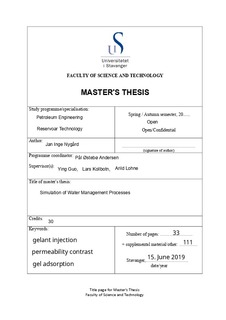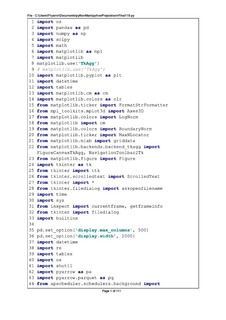| dc.contributor.advisor | Andersen, Pål Østebø | |
| dc.contributor.advisor | Guo, Ying | |
| dc.contributor.advisor | Kollbotn, Lars | |
| dc.contributor.advisor | Lohne, Arild | |
| dc.contributor.author | Nygård, Jan Inge | |
| dc.date.accessioned | 2019-10-02T08:42:09Z | |
| dc.date.available | 2019-10-02T08:42:09Z | |
| dc.date.issued | 2019-06-15 | |
| dc.identifier.uri | http://hdl.handle.net/11250/2619793 | |
| dc.description | Master's thesis in Petroleum technology | nb_NO |
| dc.description.abstract | Conformance control practices are commonly used to tackle issues related with injected fluids bypassing potentially oil-bearing formations, due to the presence of conductive fractures. To improve the prospect of such a project one may apply a gel treatment process to plug the problematic zone. One of these processes involve plugging off high-permeable thief zones by injection of a chemical solution slug that hardens to form a gel once specific in-situ conditions are met, thus diverting injected fluids to the surrounding matrix and previously bypassed oil.
One of the challenges with such an endeavour is to determine the appropriate composition, injection rate and injection volume of the chemical solution. If insufficient volume is injected the plug may not set properly, or set in the wrong place. While, if too much is injected the plug may end up too close to, or even break into, the producer well. The injection rate is also critical as too slow injection may cause the chemical solution to harden before reaching its destination, while too strong injection might squeeze it into areas where its not wanted. Other challenges relate to the hardening time, which controls whether the slug hardens sooner or later, and its dependency on pH of injected brine, temperature profile along the chemical plug, and the exchange of ions due to interaction with in-situ rock and fluids in the waterflooded region.
In this study we look at the use of a sodium-silicate solution for in-depth placement of a gel plug. We find that that will become chemical plug, shutting off larger fractures. The involved chemicals are environmentally friendly and allowed for use on the Norwegian Continental Shelf (NCS).
We perform this study using IORCoreSim which has the built-in functionalities for modelling the chemical and kinetic behaviors of the considered silicate solution. As a secondary part of this objective, we develop a software tool that is able to visualize large amounts of data, while minimum effort is needed to prepare figure-plots appropriate for use in scientific work. This tool is used to build an understanding of the involved mechanisms, such as how the conditions for water conformance control might change with higher degrees of complexity. | nb_NO |
| dc.language.iso | eng | nb_NO |
| dc.publisher | University of Stavanger, Norway | nb_NO |
| dc.relation.ispartofseries | Masteroppgave/UIS-TN-IER/2019; | |
| dc.rights | Navngivelse 4.0 Internasjonal | * |
| dc.rights.uri | http://creativecommons.org/licenses/by/4.0/deed.no | * |
| dc.subject | petroleumsteknologi | nb_NO |
| dc.subject | petroleum engineering | nb_NO |
| dc.subject | reservoarteknologi | nb_NO |
| dc.subject | reservoir technology | nb_NO |
| dc.subject | reservoir engineering | nb_NO |
| dc.title | Simulation of Water Management Processes | nb_NO |
| dc.type | Master thesis | nb_NO |
| dc.description.version | updatedVersion | nb_NO |
| dc.subject.nsi | VDP::Technology: 500::Rock and petroleum disciplines: 510::Petroleum engineering: 512 | nb_NO |


